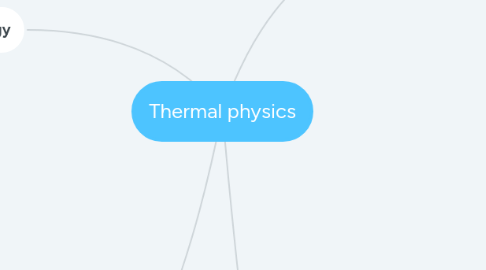
1. Transfer of energy
1.1. CONVECTION
1.1.1. Convection currents can be demonstrated by heating a fluid such as a coloued fluid in water or smoke in air. The movement of the colored fluid can show the path the fluid travels along as it expands/contracts.
1.2. RADIATION
1.2.1. Types of radiation:
1.2.1.1. UV
1.2.1.2. Gamma
1.2.1.3. Infrared
1.2.1.4. X-ray
1.2.2. Everything emits radiation
1.3. Conduction
1.3.1. Particles store heat energy as vibration, these vibrations are passed throughout the substance through vibrations
1.3.2. Metals are good conductors
1.3.3. Wood and air are bad conductors
1.3.4. The ability of a material to conduct can be determined by heating it and measuring the time taken for the temperature to change in a different part of the material.
2. Particles
2.1. Absolute zero
2.1.1. –273 °C OR 0ºK
2.1.1.1. Here particles in a substance have no remaining kinetic energy.
3. Heat energy
3.1. Internal Energy
3.1.1. The potential energy and the kinetic energy
3.1.2. Internal energy is the sum of the potential energy and kinetic energies of the particles inside an object.
3.2. Temperature
3.2.1. Temperature is a measure of how hot something is. It is proportional to the kinetic energy of the particles that constitute the material.
3.2.2. Measured in Celsius or Kelvin
3.2.3. RELATIONSHIP WITH PRESSURE
3.2.3.1. As volume increases, pressure increases in an inversely proportional manner
3.2.3.2. As temperature increases pressure increases proportionally
3.3. Specific Heat capacity
3.3.1. We can use the specific heat capacity of a material to calculate the amount of heating required to warm an object, or to find out how much heating the object will cause to its surroundings when it is allowed to cool.
3.3.2. Compares materials despite size
3.3.3. The specific heat capacity of a material is the energy which can be stored internally per kilogram of that material per degree of temperature change.
3.3.4. Compares objects NOT materials
3.3.5. Energy needed to raise an object 1C
3.3.6. Q = mc∆ T
3.3.6.1. m=mass
3.3.6.2. c = specific heat
3.3.6.3. ∆ T = change in temperature
3.4. Relationship between pressure, volume and temperature
3.4.1. Pressure x volume = Pacm^3
3.4.2. Boyle's law
3.4.2.1. If pressure increases, volume decreases, temperature increases
3.4.2.2. PV = constant
3.4.2.2.1. P = pressure
3.4.2.2.2. V = volume
3.4.2.2.3. This relationship only applies if the temperature of the gas is kept constant during any compression or expansion which takes place.
3.5. Thermal expansion
3.5.1. Solid:
3.5.1.1. As the particles in a solid cannot move (other than vibrate), only a relatively small amount of expansion can take place.
3.5.2. Gas
3.5.2.1. The particles in a gas are fully free to move about and so heating will cause a great deal of expansion if the gas is kept at constant pressure
4. State of matter
4.1. Gas
4.1.1. No fixed shape
4.1.2. Less dense
4.1.3. Particles move faster
4.1.4. Quickly fills any space
4.1.5. Virtually free of any attraction
4.2. Liquid
4.2.1. Has a fixed volume but shape can vary
4.2.2. Particles are close together and attract each other
4.2.3. They vibrate so vigorously, the attraction cannot hold them in a fixed shape
4.3. Solid
4.3.1. Fixed shape or volume
4.3.2. Very strong force of attraction
4.3.3. Particles vibrate but cannot change position
4.4. Changes
4.4.1. Evaporation VS boiling
4.4.1.1. Evaporation only happens at surface
4.4.1.2. Boiling has bubbles and higher temperature
